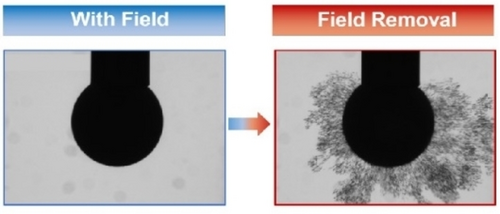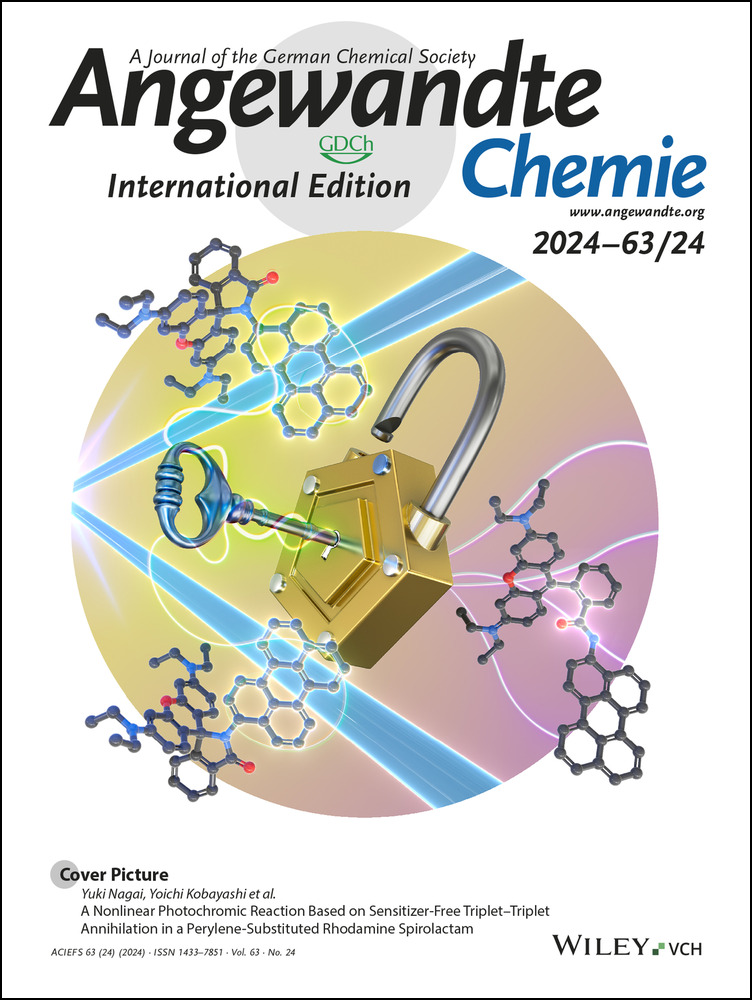Oversaturating Liquid Interfaces with Nanoparticle-Surfactants
Dr. Xuefei Wu
Materials Sciences Division, Lawrence Berkeley National Laboratory, Berkeley, CA-94720 USA
These authors contributed to this work equally.
Search for more papers by this authorDr. Han Xue
Materials Sciences Division, Lawrence Berkeley National Laboratory, Berkeley, CA-94720 USA
These authors contributed to this work equally.
Search for more papers by this authorDr. Zachary Fink
Materials Sciences Division, Lawrence Berkeley National Laboratory, Berkeley, CA-94720 USA
Polymer Science and Engineering Department, University of Massachusetts, Amherst, MA-01003 USA
Search for more papers by this authorDr. Brett A. Helms
Materials Sciences Division, Lawrence Berkeley National Laboratory, Berkeley, CA-94720 USA
Molecular Foundry, Lawrence Berkeley National Laboratory, Berkeley, CA-94720 USA
Search for more papers by this authorDr. Paul D. Ashby
Molecular Foundry, Lawrence Berkeley National Laboratory, Berkeley, CA-94720 USA
Search for more papers by this authorProf. Ahmad K. Omar
Materials Sciences Division, Lawrence Berkeley National Laboratory, Berkeley, CA-94720 USA
Department of Materials Science and Engineering, University of California, Berkeley, Berkeley, CA-94720 USA
Search for more papers by this authorCorresponding Author
Prof. Thomas P. Russell
Materials Sciences Division, Lawrence Berkeley National Laboratory, Berkeley, CA-94720 USA
Polymer Science and Engineering Department, University of Massachusetts, Amherst, MA-01003 USA
Advanced Institute for Materials Research (AIMR), Tohoku University, 2-1-1 Katahira, Aoba, Sendai, 980-8577 Japan
Search for more papers by this authorDr. Xuefei Wu
Materials Sciences Division, Lawrence Berkeley National Laboratory, Berkeley, CA-94720 USA
These authors contributed to this work equally.
Search for more papers by this authorDr. Han Xue
Materials Sciences Division, Lawrence Berkeley National Laboratory, Berkeley, CA-94720 USA
These authors contributed to this work equally.
Search for more papers by this authorDr. Zachary Fink
Materials Sciences Division, Lawrence Berkeley National Laboratory, Berkeley, CA-94720 USA
Polymer Science and Engineering Department, University of Massachusetts, Amherst, MA-01003 USA
Search for more papers by this authorDr. Brett A. Helms
Materials Sciences Division, Lawrence Berkeley National Laboratory, Berkeley, CA-94720 USA
Molecular Foundry, Lawrence Berkeley National Laboratory, Berkeley, CA-94720 USA
Search for more papers by this authorDr. Paul D. Ashby
Molecular Foundry, Lawrence Berkeley National Laboratory, Berkeley, CA-94720 USA
Search for more papers by this authorProf. Ahmad K. Omar
Materials Sciences Division, Lawrence Berkeley National Laboratory, Berkeley, CA-94720 USA
Department of Materials Science and Engineering, University of California, Berkeley, Berkeley, CA-94720 USA
Search for more papers by this authorCorresponding Author
Prof. Thomas P. Russell
Materials Sciences Division, Lawrence Berkeley National Laboratory, Berkeley, CA-94720 USA
Polymer Science and Engineering Department, University of Massachusetts, Amherst, MA-01003 USA
Advanced Institute for Materials Research (AIMR), Tohoku University, 2-1-1 Katahira, Aoba, Sendai, 980-8577 Japan
Search for more papers by this authorGraphical Abstract
Explore the intriguing world of nanoparticle-surfactants at liquid interfaces. This study delves into how external electric fields can form and influence nanoparticle assemblies, leading to explosive emulsification behavior. It unveils a fascinating interplay between electrostatic forces and physiochemical conditions, offering a glimpse into the untapped possibilities of nanotechnology.
Abstract
Assemblies of nanoparticles at liquid interfaces hold promise as dynamic “active” systems when there are convenient methods to drive the system out of equilibrium via crowding. To this end, we show that oversaturated assemblies of charged nanoparticles can be realized and held in that state with an external electric field. Upon removal of the field, strong interparticle repulsive forces cause a high in-plane electrostatic pressure that is released in an explosive emulsification. We quantify the packing of the assembly as it is driven into the oversaturated state under an applied electric field. Physiochemical conditions substantially affect the intensity of the induced explosive emulsification, underscoring the crucial role of interparticle electrostatic repulsion.
Conflict of interests
The authors declare no conflict of interest.
Open Research
Data Availability Statement
The data that support the findings of this study are available from the corresponding author upon reasonable request.
Supporting Information
As a service to our authors and readers, this journal provides supporting information supplied by the authors. Such materials are peer reviewed and may be re-organized for online delivery, but are not copy-edited or typeset. Technical support issues arising from supporting information (other than missing files) should be addressed to the authors.
| Filename | Description |
|---|---|
| anie202403790-sup-0001-misc_information.pdf922.6 KB | Supporting Information |
| anie202403790-sup-0001-MovieS1.mp422.2 MB | Supporting Information |
Please note: The publisher is not responsible for the content or functionality of any supporting information supplied by the authors. Any queries (other than missing content) should be directed to the corresponding author for the article.
References
- 1
- 1aB. A. Grzybowski, K. Fitzner, J. Paczesny, S. Granick, Chem. Soc. Rev. 2017, 46, 5647;
- 1bD. Babu, N. Katsonis, F. Lancia, R. Plamont, A. Ryabchun, Nat. Chem. Rev. 2022, 6, 377;
- 1cR. Klajn, K. J. Bishop, B. A. Grzybowski, Proc. Natl. Acad. Sci. USA 2007, 104, 10305;
- 1dR. M. Erb, H. S. Son, B. Samanta, V. M. Rotello, B. B. Yellen, Nature 2009, 457, 999.
- 2
- 2aG. M. Whitesides, B. Grzybowski, Science 2002, 295, 2418;
- 2bX. Fang, K. Kruse, T. Lu, J. Wang, Rev. Mod. Phys. 2019, 91, 045004;
- 2cT. D. Pollard, G. G. Borisy, Cell 2003, 112, 453.
- 3
- 3aM. Li, D. Li, J. Nanopart. Res. 2016, 18, 120;
- 3bB. Bharti, O. D. Velev, Langmuir 2015, 31, 7897;
- 3cA. A. Harraq, B. D. Choudhury, B. Bharti, Langmuir 2022, 38, 3001;
- 3dP. Dommersnes, Z. Rozynek, A. Mikkelsen, R. Castberg, K. Kjerstad, K. Hersvik, J. Otto Fossum, Nat. Commun. 2013, 4, 2066.
- 4
- 4aA. Snezhko, I. S. Aranson, Nat. Mater. 2011, 10, 698;
- 4bG. Kokot, D. Piet, M. Whitesides, I. S. Aranson, A. Snezhko, Sci. Rep. 2015, 5, 9528;
- 4cJ. L. Aragones, J. P. Steimel, A. Alexander-Katz, Soft Matter 2019, 15, 3929.
- 5
- 5aD. Manna, T. Udayabhaskararao, H. Zhao, R. Klajn, Angew. Chem. Int. Ed. Engl. 2015, 54, 12394;
- 5bJ. W. Lee, R. Klajn, Chem. Commun. 2015, 51, 2036.
- 6W. Wang, W. Duan, A. Sen, T. E. Mallouk, Proc. Natl. Acad. Sci. USA 2013, 110, 17744.
- 7
- 7aW. Lee, H. Amini, H. A. Stone, Proc. Natl. Acad. Sci. USA 2010, 107, 22413;
- 7bH. Song, D. L. Chen, R. F. Ismagilov, Angew. Chem. Int. Ed. Engl. 2006, 45, 7336;
- 7cA. S. Utada, E. Lorenceau, D. R. Link, P. D. Kaplan, H. A. Stone, D. A. Weitz, Science 2005, 308, 537.
- 8
- 8aM. Cui, T. Emrick, T. P. Russell, Science 2013, 25, 460;
- 8bX. Liu, N. Kent, A. Ceballos, R. Streubel, Y. Jiang, Y. Chai, P. Y. Kim, J. Forth, F. Hellman, S. Shi, D. Wang, B. A. Helms, P. D. Ashby, P. Fischer, T. P. Russell, Science 2019, 365, 264.
- 9Y. Zou, Z. Wan, J. Guo, J. Wang, S. Yin, X. Yang, Food Hydrocolloids 2017, 63, 364.
- 10
- 10aY.-K. Park, S.-H. Yoo, S. Park, Langmuir 2007, 23, 10505;
- 10bH. Jia, Y. F. Zhang, C. Zhang, M. Ouyang, S. Du, Phys. Chem. B 2023, 127, 2258;
- 10cL. Song, B. B. Xu, Q. Cheng, X. Wang, X. Luo, X. Chen, T. Chen, Y. Huang, Sci. Adv. 2021, 7, eabk2852.
- 11P. Y. Kim, Z. Fink, Q. Zhang, E. M. Dufresne, S. Narayanan, T. P. Russell, ACS Nano 2022, 16, 8967.
- 12Y. Chai, A. Lukito, Y. Jiang, P. D. Ashby, T. P. Russell, Nano Lett. 2017, 17, 6453.
- 13
- 13aC. Huang, Z. Sun, M. Cui, F. Liu, B. A. Helms, T. P. Russell, Adv. Mater. 2016, 28, 6612;
- 13bR. Xu, T. Liu, H. Sun, B. Wang, S. Shi, T. P. Russell, ACS Appl. Mater. Interfaces 2020, 12, 18116.
- 14B. Qian, S. Shi, H. Wang, T. P. Russell, ACS Appl. Mater. Interfaces 2020, 12, 13551.
- 15B. Su, J.-P. Abid, D. J. Fermin, H. H. Girault, H. Hoffmannova, P. Krtil, Z. Samec, J. Am. Chem. Soc. 2004, 126, 915.
- 16
- 16aY. Montelongo, D. Sikdar, Y. Ma, A. J. S. McIntosh, L. Velleman, A. R. Kucernak, J. B. Edel, A. A. Kornyshev, Nat. Mater. 2017, 16, 1127;
- 16bM. E. Flatté, A. A. Kornyshev, M. Urbakh, J. Phys. Condens. Matter 2008, 20, 073102.
- 17A. Boker, J. He, T. Emrick, T. P. Russell, Soft Matter 2007, 3, 1231.
- 18X. Wu, G. Bordia, R. Streubel, J. Hasnain, C. C. S. Pedroso, B. E. Cohen, B. Rad, P. Ashby, A. K. Omar, P. L. Geissler, D. Wang, H. Xue, J. Wang, T. P. Russell, Adv. Funct. Mater. 2023, 33, 2213844.
- 19X. Wu, H. Xue, G. Bordia, Z. Fink, P. Y. Kim, R. Streubel, J. Han, B. A. Helms, P. Ashby, A. K. Omar, T. P. Russell, Adv. Mater. 2024, 2310435.
- 20R. Yang, L. Mei, Y. Fan, Q. Zhang, H. G. Liao, J. Yang, J. Li, Z. Zeng, Nat. Protoc. 2023, 18, 555.
- 21
- 21aP. Y. Kim, Y. Gao, Y. Chai, P. D. Ashby, A. E. Ribbe, D. A. Hoagland, T. P. Russell, ACS Nano 2019, 13, 3075;
- 21bP. Y. Kim, Y. Gao, Z. Fink, A. E. Ribbe, D. A. Hoagland, T. P. Russell, ACS Nano 2022, 16, 5496.
- 22
- 22aP. Pienpinijtham, X. X. Han, S. Ekgasit, Y. Ozaki, Phys. Chem. Chem. Phys. 2012, 14, 10132;
- 22bM. P. Cecchini, V. A. Turek, A. Demetriadou, G. Britovsek, T. Welton, A. A. Kornyshev, J. D. E. T. Wilton-Ely, J. B. Edel, Adv. Opt. Mater. 2014, 2, 966.
- 23
- 23aH. Tian, H. Li, Y. Fang, ACS Appl. Mater. Interfaces 2019, 11, 16207;
- 23bK. Bramhaiah, N. S. John, RSC Adv. 2013, 3, 7765;
- 23cK. Kim, H. S. Han, I. Choi, C. Lee, S. Hong, S. H. Suh, L. P. Lee, T. Kang, Nat. Commun. 2013, 4, 2182.
- 24
- 24aP. K. Jain, W. Huang, M. A. El-Sayed, Nano Lett. 2007, 7, 2080;
- 24bV. A. Turek, M. P. Cecchini, J. Paget, A. R. Kucernak, A. A. Kornyshev, J. B. Edel, ACS Nano 2012, 6, 7789;
- 24cZ. Fink, X. Wu, P. Y. Kim, A. McGlasson, M. Abdelsamie, T. Emrick, C. M. Sutter-Fella, P. D. Ashby, B. A. Helms, T. P. Russell, Small 2023, e2308560.
- 25
- 25aJ. Hu, E. W. C. Spotte-Smith, B. Pan, R. J. Garcia, C. Colosqui, I. P. Herman, J. Phys. Chem. C 2020, 124, 23949;
- 25bN. Paracini, P. Gutfreund, R. Welbourn, J. F. Gonzalez-Martinez, K. Zhu, Y. Miao, N. Yepuri, T. A. Darwish, C. Garvey, S. Waldie, J. Larsson, M. Wolff, M. Cardenas, ACS Appl. Mater. Interfaces 2023, 15, 3772;
- 25cH. Li, S. V. Roth, G. Freychet, M. Zhernenkov, N. Asta, L. Wagberg, T. Pettersson, Biomacromolecules 2021, 22, 4274;
- 25dM. K. Bera, H. Chan, D. F. Moyano, H. Yu, S. Tatur, D. Amoanu, W. Bu, V. M. Rotello, M. Meron, P. Kral, B. Lin, M. L. Schlossman, Nano Lett. 2014, 14, 6816;
- 25eL. Wu, X. Wang, G. Wang, G. Chen, Nat. Commun. 2018, 9, 1335.
- 26
- 26aV. Garbin, J. C. Crocker, K. J. Stebe, J. Colloid Interface Sci. 2012, 387, 1;
- 26bQ. Cheng, H. Fang, R. Cao, Z. Ma, S. Wang, R. Xie, H. Xia, D. Wang, Supramolecular Materials 2022, 1, 100021;
10.1016/j.supmat.2022.100021 Google Scholar
- 26cM. G. Nikolaides, A. R. Bausch, M. F. Hsu, A. D. Dinsmore, M. P. Brenner, C. Gay, D. A. Weitz, Nature 2002, 420, 299.
- 27T. Li, A. J. Senesi, B. Lee, Chem. Rev. 2016, 116, 11128.
- 28J. Forth, P. Y. Kim, G. Xie, X. Liu, B. A. Helms, T. P. Russell, Adv. Mater. 2019, 31, e1806370.
- 29S. Mhatre, S. Simon, J. Sjoblom, Anal. Chem. 2020, 92, 12860.
- 30Q. Liu, Z. Sun, J. C. Santamarina, J. Colloid Interface Sci. 2021, 581, 251.
- 31K. Roger, B. Cabane, Angew. Chem. Int. Ed. Engl. 2012, 51, 5625.
- 32C. H. Meredith, P. G. Moerman, J. Groenewold, Y. J. Chiu, W. K. Kegel, A. van Blaaderen, L. D. Zarzar, Nat. Chem. 2020, 12, 1136.
- 33J. Kimling, M. Maier, B. Okenve, V. Kotaidis, H. Ballot, A. Plech, J. Phys. Chem. B 2006, 110, 15700.





